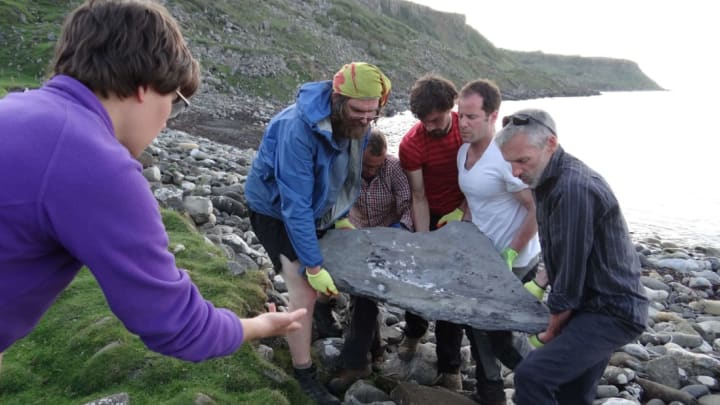Though we still have a lot to learn about the dinosaurs who walked the Earth, we know even less about the prehistoric reptiles who took to the sky. Due to the nature of their bones and their environment, pterosaurs (often called pterodactyls) didn't leave many fossils behind for us to study. That's why paleontologists are celebrating the discovery of a pterosaur fossil made on the Isle of Skye in Scotland. As CBS News reports, the 170 million-year-old fossil belonged to the largest known prehistoric flying reptile of its age.
Ph.D. student Amelia Penny first spotted the toothed jawbone poking out of the rocks on a field trip to the island in 2017. Further research led by Natalia Jagielska, a doctoral student at the University of Edinburgh, revealed the partial skeleton of a new species of flying reptile. The creature has been named Dearc sgiathanach (pronounced jark ski-an-ach), which translates to "winged reptile" in Gaelic and gives a nod to the Isle of Skye's Gaelic name meaning "the winged isle." The findings are reported in the journal Current Biology.

The pterosaur's wingspan stretched 8 feet—roughly the same as that of a modern albatross. The fossil dates backs to the Middle Jurassic, which paleontologists had previously assumed to be an era of much smaller winged reptiles. Though it's dwarfed by the airplane-sized pterosaurs of the Cretaceous period, Dearc sgiathanach was still a formidable predator during its time.
"[Its size] tells us that pterosaurs got larger much earlier than we thought, long before the Cretaceous period when they were competing with birds, and that's hugely significant," paleontogist Steve Brusatte, the University of Edinburgh professor who lead the field trip where the fossil was discovered, said in a news release. "The preservation is amazing, far beyond any pterosaur ever found in Scotland and probably the best British skeleton found since [...] the early 1800s."

Like modern birds, pterosaurs had delicate, "feather-light" bones that rarely survived to the present day. And unlike some dinosaur species, only a fraction of pterosaurs died in places where their bodies would be preserved. After resting in the rocks of the Isle of Skye for millions of years, the pterosaur fossil will be added to the collection of the National Museum of Scotland in Edinburgh.
[h/t CBS News]
